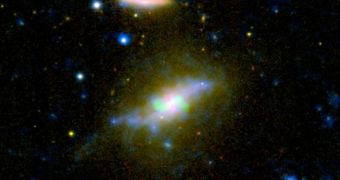An unfortunate combination of elements is conspiring to remove most star-forming materials from within the boundaries of a nearby galaxy. Astronomers have termed this process the leaf blower effect.
This was discovered in studies conducted using the NASA Galaxy Evolution Explorer (GALEX) spacecraft, which surveys the sky in ultraviolet wavelengths. Data from a series of other instruments were introduced into the research as well.
According to the team that conducted this investigation, the work may help significantly improve our current understanding of galactic evolution. The scientists say that the jets of a supermassive black hole are working together with supernova explosions to remove star-forming material from the galaxy.
The object, called NGC 3801, is an elliptical galaxy. This class of cosmic structures is believed to originate from collisions and mergers between two or more spiral galaxies, like the Milky Way.
One of the main things differentiating the two types of galaxies is the fact that spiral ones still produce new stars, whereas elliptical ones do not. Astronomers believe that NGC 3801 is in an intermediary stage, meaning that it is currently on the verge of stopping all of its stellar-forming processes.
“We have caught a galaxy in the act of destroying its gaseous fuel for new stars and marching toward being a red-and-dead type of galaxy,” Ananda Hota explains. This is the name experts give to elliptical galaxies, since they are dominated by red stars, and display no new stellar formation.
Hota conducted the study while a post-doctoral research fellow with the Institute of Astronomy & Astrophysics at Academia Sinica in Taipei, Taiwan. He is also the lead author of a paper detailing the findings, which appears in the latest issue of the Monthly Notices of the Royal Astronomical Society.
“We have found a crucial missing piece to connect and solve the puzzle of this phase of galaxy evolution,” he says, adding that supernova explosions have long since been considered responsible for destroying stellar nurseries' ability to create new, blue stars.
Now, experts have evidence that the same is true for whole galaxies. When stars explode, they create such enormous shock waves that all molecular hydrogen gas around them is dispelled. As this happens repeatedly, the process is never-ending, inevitably leading to the emergence of red-and-dead-type galaxies.
Infrared data from the NASA Spitzer Space Telescope, which is managed by the Jet Propulsion Laboratory (JPL), were also included in the research.

 14 DAY TRIAL //
14 DAY TRIAL //